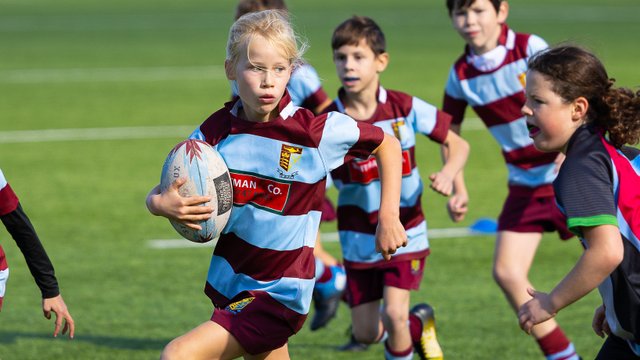Team info
Under 8 (Year 3)
Playing in teams of 6, provides more of a team “feel” whilst maintaining the principles of low numbers and increased involvement. The players are now able to go to ground to score – which introduces the element of contact with ...


About the team
Playing in teams of 6, provides more of a team “feel” whilst maintaining the principles of low numbers and increased involvement. The players are now able to go to ground to score – which introduces the element of contact with the ground.
Personal and Social
Play Fairly
The child can:
- Understand and respect simple rules
- Play by the rules
- Accept decisions.
Be confident
The child is:
- Keen to have a go and try new things
- Willing to demonstrate to others
- Able to accept constructive feedback.
Physical and Movement
Link two skills
The child can:
- Catch and pass the ball.
Perform skills with some control and consistency
The child can:
- Catch and pass in one movement
- Can catch and pass the ball in one movement while running.
Game Understanding
Understand performance (how to improve)
The child can:
- Describe what has been performed
- Explain why something or someone is good
- Describe what leads to team /individual improvement.
Use basic tactics and strategies
The child can:
- Suggest solutions or basic tactics
- Understand differences in simple tactics (attack and defence)
- Choose and put tactics into practice in different situations
- Change tactics/rules to make the game successful.
Skill focus
Passing
The child can:
- Pass the ball while moving.
Catching
The child can:
Make a target
- Call for the ball
- Get into a good position to catch the ball (in space/not too far away)
- Keep the ball away from the body
- Catch the ball while moving.
Rules
- 6 v 6
- 22m x 45m
- No coaches on the pitch
- Permitted to go to ground to score
- Size 3 ball
[b]Competition Framework[/b]
- Inter-club
- Triangular
- Festival: round robin, rock up and play. No leagues or knock-out.
6-a-side Tag Rugby
1. Pitch size 45m x 22m (maximum)
2. Tag belts clearly visible, excess strap tucked away, 1 tag each side.
3. Ball should be passed sideways or backwards.
4. Ball carrier should pass when tagged within approx 3 metres or approx 3 seconds.
5. Opponents must allow them to pass and try hard to get in front of the ball (off side).
6. Ball carrier cannot continue to play until both tags are attached.
7. Tagger cannot continue to play until s/he has returned tag.
8. If the ball is propelled forward (dropped, knocked forward or passed forward) a free pass will be given by the opposition unless there is an advantage to the non-offending team
9. A try is scored when the ball carrier has placed the ball over the line. Re start from centre with free pass
10. If the ball carrier is tagged within approx 1 metre of the try line a score can be made.
11. No Physical contact (including fending off with hands, or ball)
12. If a free pass is awarded the opposition should be 3 meters back, toward their own try line. Free passes may not take place within 3 metres of the try line.
13. Players may not dive on the ball.
Training
Upcoming




